How to Plan the Perfect Customer Visit [+ Agenda Template]
Published: August 02, 2021
Now that the world is opening back up, it’s time to get out there and meet your customers face-to-face. For many newer customers, this might be their first time getting to spend time with you — especially as conferences have moved online.

Creating that connection is invaluable. But before you book that plane ticket, it’s essential to create a plan. Planning the perfect customer visit will ensure that you meet your goals and that your customer meeting will be successful. Here’s a look at how you get there.
![onsite visit → Free Download: 61 Templates to Help You Put the Customer First [Download Now]](https://no-cache.hubspot.com/cta/default/53/a66c79d4-2a39-46e6-a80a-f7b999133c06.png)

Why plan a customer visit?
Jason Lemkin, the founder of SaaStr and EchoSign, has said “ I never lost a customer I actually visited. ” That’s a bold statement — one that's worth taking note of. But why? What is it about customer visits that has such a big impact on customer loyalty?
First of all, you get to make a stronger impression with your customers. No matter what you sell, you aren’t just selling a product — you’re also selling the people behind it.
Your vision, your passion, your knowledge are all play into the perceived value of your product or service. All of these elements come across more strongly when you visit in person. A Zoom call just isn’t enough time to go deep.
Secondly, you get to see how your customers are using your product in person. Are they constantly printing out reports to pin up on a wall? Are you seeing teams walk across the sales floor to point out something on a screen? What kind of working environment and equipment do they have? What other types of software are they using?
Everything happening behind the scenes paints a much clearer picture of who your customers are. And when it comes time to renew or jump on that next customer success call, you’ll have a lot more knowledge ready to draw on.
Finally, meeting your customers in person is a huge motivational boost! When you’re behind a screen for so long, it can start to feel like what you do doesn’t matter — or that you’re not making any real connections. But a visit to a customer’s office can change all that, and really light up your idea of “why” you do this at all.
.png)
61 Templates to Help You Put the Customer First
Email, survey, and buyer persona templates to help you engage and delight your customers
- 6 buyer persona templates
- 5 customer satisfaction survey templates
- 50 customer email templates
You're all set!
Click this link to access this resource at any time.
5 Potential Goals of Your Customer Visit
Going into a customer visit with goals in mind will help you get the most out of your time there. Here are five goals to consider when planning a customer visit:
1. Understanding Their Business Goals
If you’re visiting a client, you’re likely hoping for a long term relationship. Understanding what their future goals are can help align your product with their needs. These in-depth conversations would rarely come up over a quick phone call.
2. Gathering Feedback
Customer visits provide a unique opportunity to gather honest and in-the-moment insight into what your customers need and want. When you sit next to someone who uses your product in their daily work, there’s a lot more space to have this feedback arise. And documenting it for future sales opportunities and your product team is one of the more productive actions you can take during a customer visit.
3. Referrals
In-person visits are a great time to ask for and give referrals. Ask, “Are there any other companies that you work with that you could see our product being helpful for?” Alternatively, if a pain point is mentioned by the client and you know the perfect company to help solve it, don’t be afraid to build that connection. It’s just another way you can bring value to your customers.
4. Uncovering Opportunities for Cross-Selling or Upselling
While your primary objective shouldn’t be pitching your offering at every opportunity, you might uncover a problem that your product or service can help solve. Noting these potential value-adds can make for more effective, thoughtfully targeted upsell and cross-sell conversations.
5. Testimonials and Case Studies
Customer visits can be a unique source of sales content, including pictures for case studies, video testimonials, and strong evidence-based customer stories. If you plan on making this one of your primary goals, consider asking your client to set the stage for these kinds of materials before you visit so you already know who you’ll be speaking to, before coming onsite.
How to Plan an Onsite Customer Meeting
By putting more effort in before you go, you’ll have a much better chance of achieving your goals and impressing your clients. Here are some key actions to consider when planning your customer meeting.
Thoroughly prepare before the visit.
Before you arrive, make sure you’re up to date on the state of the customer's account. Who are they usually talking to at your company? What customer service tickets have they raised lately? Are there outstanding issues that need to be addressed? These will come up during your visit.
Secondly, understand the current ecosystem your customer is working within. Is your customer in the news? What’s happening in their industry? What threats and opportunities are arising in their business? Being prepared and knowledgeable about their inner workings will make a better impression than coming in blind.
Decide who you’re meeting with.
Start by setting up a meeting with relevant company leadership. That could be the CEO, the founders, or the VP of the functional team you're working with — depending on the company's scale. Bear in mind, while this contact might be the "reason" for your visit, they're probably not who you'll be spending the most time with.
Once you have a meeting scheduled with the company's leadership, plan the rest of your day around meeting with the team leaders and employees using your product — as well as any teams that are open to signing up or expanding the current seat count or contract scope.
Make dinner reservations for you and your clients.
Traditionally, a customer visit includes taking your client out for a nice dinner as a token of appreciation. It also offers a chance for you to get to know each other outside of the limits of the work environment and form stronger relationships.
That being said, this is not a social visit. Keep your goals in mind — even outside of work hours. If you’re familiar with the restaurants in the area, choose a place that has options for every diet and has a good atmosphere for conversations. If you’re not familiar with the available options, ask the client where they’d recommend.
Complete the wrap-up report.
After the visit is over, you still have work to do. Create a wrap-up report for your internal teams back at the office. It should cover key elements of the visit like any confidentiality agreements put in place and who at your company you can share contact information or sales figures with.
Identify any action items that came up during the visit. Include any positive highlights during the meeting as well as any risks or opportunities that arose. Create a copy of the report for your client as well, to show that you were listening to their concerns and that you’re going to follow up with them.
Customer Visit Agenda Template
Use this sample agenda to plan your own customer visit.
10 am: Welcome/Office Tour (30 minutes, w/ Stacy, Raul)
- Get settled, set up a desk or boardroom for the day
11 am: Executive Meeting (1 hour, w/ Stacy, Thomas, Ankit, Shireen)
- Overview of status, product usage, any updates
- Add any bullet points you need to cover here
- Upcoming changes or challenges for the business
- New Opportunities
- Areas of concern
12pm: Lunch
1pm: User Meetings (4 hours, rotating through Marketing teams)
- Overview of new features
- Gather feedback from users
- Sit with teams to review workflow
5pm: Wrap Up meeting (30 minutes)
- Process or configuration change recommendations
- General questions and answers
- Items to be addressed as part of maintenance
- Enhancement opportunities
6:30pm: Dinner at Restaurant
Internal Notes
- At the bottom of your agenda, include internal notes that are meant to be shared with your team only.
Plan for success
It’s time to get back out there and meet your clients face-to-face. By planning your customer visit ahead of time, you’re sure to achieve your goals and come out with a stronger understanding of what your clients need.

Don't forget to share this post!
Related articles.

9 Bad Sales Habits (& How to Break Them In 2024), According to Sales Leaders
![onsite visit 22 Best Sales Strategies, Plans, & Initiatives for Success [Templates]](https://blog.hubspot.com/hubfs/Best-Sales-Strategies-1.png)
22 Best Sales Strategies, Plans, & Initiatives for Success [Templates]

9 Key Social Selling Tips, According to Experts
![onsite visit 7 Social Selling Trends to Leverage This Year [New Data]](https://blog.hubspot.com/hubfs/social%20selling%20trends.png)
7 Social Selling Trends to Leverage This Year [New Data]
![onsite visit How Do Buyers Prefer to Interact With Sales Reps? [New Data]](https://blog.hubspot.com/hubfs/person%20phone%20or%20online%20sales%20FI.png)
How Do Buyers Prefer to Interact With Sales Reps? [New Data]
![onsite visit 7 Sales Tips You Need to Know For 2024 [Expert Insights]](https://blog.hubspot.com/hubfs/Sales%20Tips%202024%20FI.png)
7 Sales Tips You Need to Know For 2024 [Expert Insights]

What is Sales Planning? How to Create a Sales Plan

Sales Tech: What Is It + What Does Your Team Really Need?
![onsite visit 10 Key Sales Challenges for 2024 [+How You Can Overcome Them]](https://blog.hubspot.com/hubfs/sales%20challenges%20FI.png)
10 Key Sales Challenges for 2024 [+How You Can Overcome Them]
![onsite visit The Top Sales Trends of 2024 & How To Leverage Them [New Data + Expert Tips]](https://blog.hubspot.com/hubfs/sales-trends-2023.png)
The Top Sales Trends of 2024 & How To Leverage Them [New Data + Expert Tips]
Free email, survey, and buyer persona templates to help you engage and delight your customers.
Powerful and easy-to-use sales software that drives productivity, enables customer connection, and supports growing sales orgs
- SOC 1 Audit
- SOC 2 Audit
- Cloud Security
- HIPAA Audit
- ISO 27001 Audit
- Privacy Audit
- Risk Assessments
- Vendor Compliance Assessment
- Advisory Services
- Web Application
- Mobile Application
- Code Review
- Social Engineering
- Compliance Glossary
- Media Resources
- Press Releases
- White Papers
- Online Audit Manager
- Meet the Auditors
- Working at KirkpatrickPrice
- Testimonials
- Quality Audit
- Connect with an Expert

5 Ways to Prepare for Your Onsite Visit
At KirkpatrickPrice, we’re committed to helping our clients get the most out of their information security engagements with us. That’s why we insist that our audits include an onsite visit. It’s part of performing our due diligence and testing. So, what happens during an onsite visit? How can organizations calm their nerves and prepare for an onsite visit?
What Happens During an Onsite Visit?
Once an organization has completed about 80% of its Online Audit Manager responses, we schedule an onsite visit. During this 3- to 4-day visit, an auditor has three tasks: interview, review, and observe. The auditor will interview the personnel responsible for various activities, physically test your networks, systems, and devices, and observe your company culture. While this process may seem straightforward, we understand that having an auditor come onsite can be stressful and nerve-wracking. What exactly are auditors looking for? Who will they talk to? What will they ask? Let’s take a look at how organizations can prepare for an onsite visit.
How Can I Prepare My Organization for an Onsite Audit Visit?
Every organization is different when it comes to onsite visits: levels of preparedness differ, the buy-in from personnel differs, and even the resources needed to get through the onsite differ. Regardless of this, though, every organization can proactively set itself up for success by implementing the following five practices to prepare for an onsite visit.
1. Relax! Remind Yourself Why You’re Doing This Audit
The goal of compliance, and especially the onsite visit, is to make your organization stronger . Auditors aren’t there to get you fired. An auditor finding vulnerabilities means doesn’t mean you’ve failed – finding vulnerabilities is the only way an auditor can help you! It means that you’re receiving a thorough audit – one that will only strengthen your security in the long run. Before your onsite visit begins, remember to relax and remind your personnel what this audit means to your organization. Does it mean more revenue? Bigger clients? New industries? New locations? To hone in on the value of compliance, you might consider sending out a company-wide email prior to the auditor coming onsite, similar to the one our client sent out. This is something that acknowledges how all employees play a role in compliance, explains what compliance means for your organization, and provides reminders of what not to do when an auditor is onsite.

2. Ask Questions, Voice Concerns
At KirkpatrickPrice, we know that undergoing any type of information security audit is difficult and stress-inducing. Often times, clients have questions, concerns, and even fears going into the onsite visit – and we want to reiterate that we are always here to help. Before the onsite visit then, ask your questions and voice your concerns. Our auditors can’t answer questions that never get answered or address concerns that are never shared. This level of transparency builds our relationship and will only help the success of your audit.
3. Review the Agenda
The best auditors will supply you with an agenda of topics prior to the onsite visit, so be sure to work with your auditor to ensure that you have the right personnel lined up to speak to an auditor. This will help prevent any confusion or stress when the auditor comes onsite. If your staff knows when they’ll be interviewed, they’ll be much more prepared.
4. Involve Senior Management
At every stage of an information security engagement, senior management involvement is extremely important, although this is especially true when it comes to the onsite visit. The best auditors will be sure to hold briefings will all involved in the audit at both the start and finish of the onsite engagement. This gives the auditor the opportunity to address questions about the timeline, expectations for the group, any issues in need of attention, as well as any other notable findings. If senior management is not involved during this process, critical information could be missed, which could prolong the engagement or prevent your organization from receiving your report on time.
5. Develop a Method for Tracking Action Items
Whether it’s during the onsite visit or afterward, there will be a number of items that the auditor may ask for more information on, such as logs, files, reports, etc. Most organizations will utilize Excel or other GRC software, but at KirkpatrickPrice, we’ve developed our own online tool for tracking action items. Using a tool like KirkpatrickPrice’s Online Audit Manager can facilitate the process through various time statuses and compliance frameworks.

Have more questions about our audit process? Want more information on how to prepare for your next onsite visit? We’re here to help! Contact us today to speak to one of our Information Security Specialists.
More Onsite Visit Resources
Remote Auditing vs. Onsite Assessments: What Do I Want?
Why Quality Audits Will Always Pay Off: You Get What You Pay For
Was the Gap Analysis Worth It?
Was the Audit Worth It?
Related Posts
Have you received a questionnaire from the OCR regarding Phase 2 of the HIPAA Audit…
FISMA is U.S. legislation enacted as part of the Electronic Government Act of 2002, intended…
Phase 2 of HIPAA Audit Program Expected in 2015. The U.S. Department of Health and…
- Auditor Insights
- The Audit Process
- Compliance Best Practices
- Industry News
- Webinars + Events
- Application Development
- Configuration Management
- Data Security
- Environmental Security
- Human Resources
- Information Security Policy
- Logical Access
- Management Control
- Network Monitoring
- Penetration Testing
- Physical Security
- Regulatory Compliance
- Risk Assessment
- Service Delivery
- Vendor Management

6 Engineering Site Visit Checklist Tips to Know
An engineering site visit checklist is critical for most projects. It’s the reality check that keeps designs grounded in the real world.
Site visits are the ultimate way to get up close and personal with a project and the client. You’ll usually find yourself making site visits during these project stages:
- Project kickoff to grasp the work scope
- Design phase to fine-tune project details
- Construction phase to tackle problems
- Start-up post-construction to ensure everything’s running smoothly
To make the most of each site visit, follow my 6 engineering site visit checklist tips. I’ll focus on design phase visits, but these takeaways apply to all stages. Also, enjoy some rad photos from a hydroelectric facility I helped retrofit.
#1 Map out a solid plan of action for your site visit
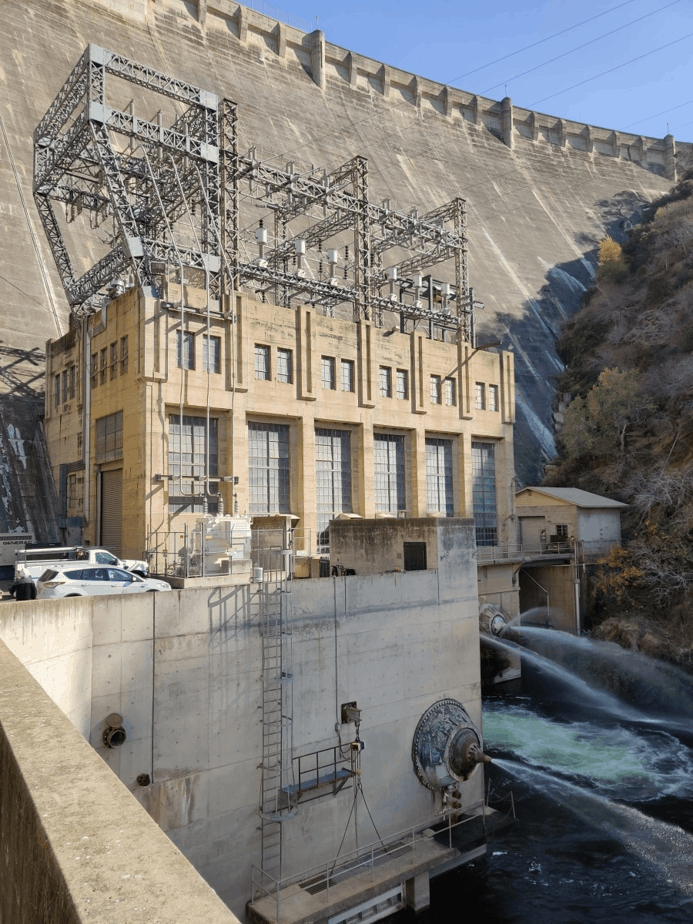
Preparation is the name of the game. Before I set foot on a site, I know exactly what I need to do there.
Take this example: say my project is to upgrade an existing substation for increased capacity. I’d first make a list of questions for the client and items to investigate at the site.
Client questions might include:
- Do you have existing as-built drawings and specs?
- How much new load are you forecasting?
- Can you break down the existing loads?
- Are there any issues I should know about?
- Is any existing equipment causing trouble?
- How much space is there to expand the substation?
- What’s your lead time for this project?
- How much downtime can you handle during the cutover phase?
- Are other upgrades needed (e.g., security, protective relaying)?
My site investigation checklist would include:
- Confirm equipment ratings
- Measure clearances
- Snap photos inside panels (e.g., control panels)
- Inspect existing equipment (e.g., switchgear, transformers)
- Measure space for new equipment
- Check transmission and distribution line connections
- Look for facility quirks or safety concerns
Keep in mind, I might tackle some tasks over the phone or through email before the visit. This way, the client can gear up for our powwow and avoid wasting precious time.
For instance, there have been times when I forgot to mention that I needed to inspect panel X. At the site, the client told me they couldn’t access it.
Come prepared to keep site visits efficient
When you visit a site, your client will most likely show you around. You won’t have all the time in the world to explore and brainstorm on the fly. Besides, you don’t want to come across as a clueless, unprepared engineer.
So, treat a site visit like any other high-stakes meeting. Some site visits can take months to arrange, so it’s best to know exactly what you want to achieve before you even set foot on the site. You don’t want to return from the visit kicking yourself, thinking,
“DAMN! I forgot to take photos of the control panel’s interior!”

Important Note: Don’t forget to ask your client about any site safety concerns. This is crucial for your safety and everyone around you.
I’ve been to sites with live 230,000-volt equipment and experienced treacherous drives to sites where I’ve nearly met my maker .
#2 Investigate the site thoroughly
Time to channel your inner Sherlock Holmes! Your blueprint for this detective work is the action plan you create in tip #1.
You’ll want to check if the client’s scope of work has any limitations, or if there are other issues your client forgot to mention. Sometimes, the work scope seems straightforward on paper, but once you’re on site, you uncover a whole slew of unexpected problems.
I like to compare it to our ambition to travel and colonize Mars. From Earth, the mission appears simple: send a couple of big rockets to Mars and create an artificial habitat that provides oxygen and protection from extreme cold, high radiation, and low atmospheric pressure.
However, the reality is mind-blowing. The challenges are enormous, and there’s a never-ending list of problems we haven’t even considered yet. Just take a look at some of the issues I’ve listed here when it comes to tunneling on Mars alone.
The point is, don’t just rely on what your client tells you. You’re the expert, so it’s up to you to investigate the site and determine what’s best for your client. After that, you can discuss your findings with them and fine-tune the work scope.
#3 Snap loads of pictures at the site

Nowadays, everyone has a high-end camera in their pocket with their smartphone. You can take endless top-quality photos on a whim. But, you need to know how to take great photos at a project site too.
Otherwise, when you return to your office, your photos might only cause more confusion. To avoid this, I’ll share four tips on how to take and manage pictures (and videos) effectively.
A) Organize and separate your photos on site
Picture yourself at a project site, snapping away photos, feeling like you’ve got everything under control. You think you’ll remember why and where each shot was taken. But let’s be real, once you’re back in your office, it’s a hot mess trying to figure out which photos belong where.
Imagine taking 50 pictures at location A and another 50 at locations B and C. To keep things organized, I whip out my trusty notepad, jot down the location or equipment, and snap a photo of it. Here are some examples of what I write:
- Inside building X looking at the west wall
- Inside the left-most cabinet of switchgear ‘Faulk’
- Investigating high voltage cabling of switchgear ‘Faulk’
With my digital divider in place, I only then start snapping field photos. Once I’m done, I move on to the next spot and repeat the process. Trust me, this technique is a lifesaver when you’re dealing with hundreds of photos.
B) Take photos in a patterned consistent manner
So, you want to capture the components in a 90-inch tall control panel? First, step back and get an overall shot of the panel. Then, zoom in and snap photos of the components from top to bottom.
This way, you can easily understand the mounting arrangement of the components in the zoomed-in photos. I’ve had moments where I didn’t take zoomed-out photos, and back in the office, it was a nightmare trying to follow the wiring of the components. Super frustrating!
C) Upload and organize your photos ASAP
Get those photos uploaded and organized right after your site visit, while everything’s still fresh in your head. If you missed any of the earlier photo tips, you’ll remember the details and make a note.
Next, turn each of your written notes from photo tip ‘A’ into separate folders. For example, if you took pictures at three different spots on your project site, your digital file organization would look something like this:
Main folder: Site Visit at Zeus Substation (DD/MM/YY)
Subfolders:
- Location #1
- Location #2
- Location #3
Lastly, give each of your photos a detailed name. Invest a little time now, and you’ll save yourself from future headaches.
D) Take a lot of photos
Back in the day, film was expensive, so you had to be stingy with your shots. But now, there’s no reason not to go photo-crazy! Plus, you can review the quality of each photo right there on the spot.
So go ahead, take loads of photos and even videos. They’ll only help you back at the office. I say, if a photo has even a 1% chance of being useful, take the shot! You never know when those seemingly pointless pics might save the day.
#4 Bring all your necessary supplies to the site
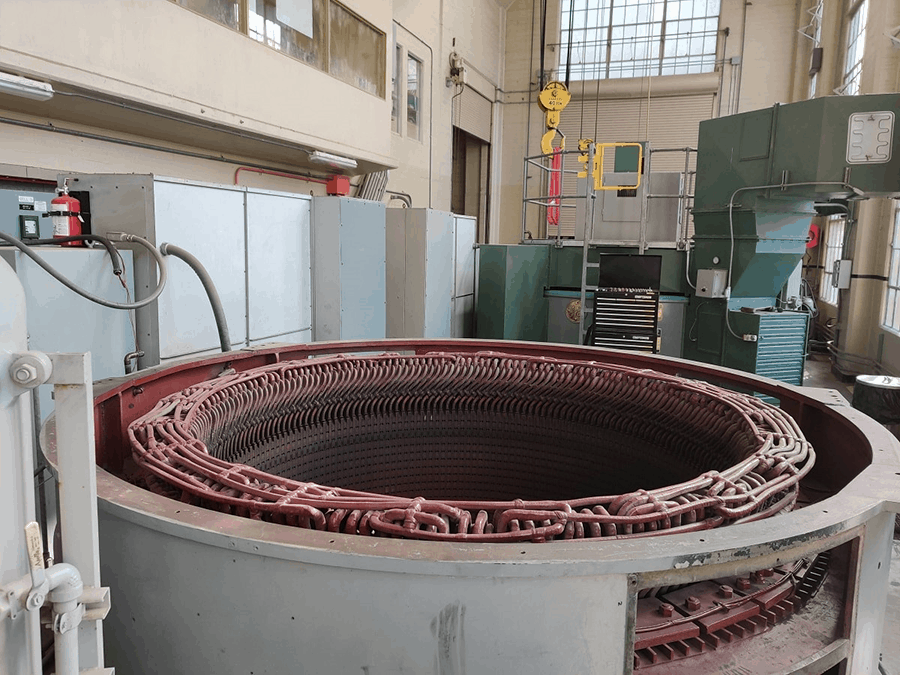
Depending on your field of engineering, you’ll have a bunch of supplies to bring along. My list is always pretty lengthy . Don’t expect your client to hook you up with supplies, especially since they’re paying you!
So pack for the unexpected and bring all your gear just in case. You never know when you’ll need to measure a piece of equipment or pry open a panel. If you’re not prepared, you’ll miss out on valuable data.
#5 Forge a strong connection with your client during site visits
Nothing beats getting to know your client face-to-face, right? Sure, digital communication is a breeze these days, with everyone clutching their trusty smartphones.
But, let’s be real – in-person interactions still reign supreme. That’s why I think site visits are the perfect chance to bond with your client.
Without a face to match the name, you’re just another entry on their spreadsheet. Genuine human connections, on the other hand, pave the way for deeper relationships. This usually leads to smoother project execution. Plus, your future requests are less likely to be left hanging.
#6 Show up on time for your site visit
This one’s a no-brainer, but punctuality is key. Actually, aim to be 10 to 15 minutes early. You don’t want to make a lousy impression by keeping your client waiting.
Go the extra mile to pinpoint the precise site location in advance. This might mean asking your client for map snapshots and off-the-beaten-path directions. After all, some engineering project sites can be in the boonies, with no physical address that your GPS can easily locate.
I’d recommend downloading the site map on your phone, just in case you lose signal. Alternatively, use a non-internet-dependent GPS device.
And if you’re running late, give your client a heads-up with a phone call. At the end of the day, professionalism is paramount.
Engineering site visit checklist wrap up
Site visits play a huge role in engineering projects. The better you tackle site visits, the more successful projects you’ll spearhead.
My advice? Learn about site visits specific to your engineering field . Pick the brains of seasoned engineers to discover what to look for during site visits. Then, tweak your engineering site visit checklist as needed. You might uncover something unique to your line of work that I didn’t cover.
What do you find the most important about engineering project site visits? What’s on your engineering site visit checklist?
SUBSCRIBE TO ENGINEER CALCS NEWSLETTER
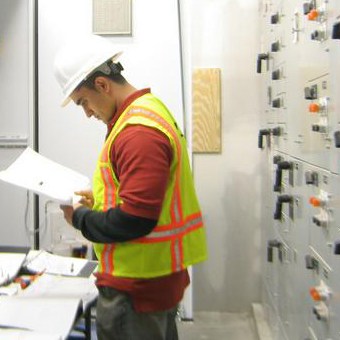
Author Bio: Koosha started Engineer Calcs in 2019 to help people better understand the engineering and construction industry, and to discuss various science and engineering-related topics to make people think. He has been working in the engineering and tech industry in California for well over 15 years now and is a licensed professional electrical engineer, and also has various entrepreneurial pursuits.
Koosha has an extensive background in the design and specification of electrical systems with areas of expertise including power generation, transmission, distribution, instrumentation and controls, and water distribution and pumping as well as alternative energy (wind, solar, geothermal, and storage).
Koosha is most interested in engineering innovations, the cosmos, sports, fitness, and our history and future.
Leave a Comment Cancel reply
Save my name, email, and website in this browser for the next time I comment.

Manage the Complete Vendor Lifecycle
Easily manage your third-party risk management activities across the vendor lifecycle – onboarding, ongoing management, offboarding.
Take a Product Tour to See Venminder in Action New

Outsource Vendor Control Assessments
Order due diligence assessments on your vendors that include qualified risk ratings and reviews from Venminder experts.

Continuously Monitor with Risk Intelligence
Seamlessly combine risk intelligence data to monitor for risks within cybersecurity, business health, financial viability, privacy, ESG and more.
Venminder experts deliver over 30,000 risk-rated assessments annually. Download samples to see how outsourcing to Venminder can reduce your workload.
Download free samples →
- Create Your Free Account
Quickly get a program in place to manage vendor risks.
Centralize to ensure program requirements are met.
Identify risk then reduce and manage it.
Hand off your document collection, control assessments and tasks.
Meet regulatory agency issued guidance.
Empower vendor owners to mitigate vendor risks.
Risk Categories
Why venminder.
Learn how our customers have managed their vendors and risk with Venminder.
Check out independent research that validates Venminder's market leader position.
See why Venminder is uniquely positioned to help you manage vendors and risk.
Our team is committed to a single goal: a customer experience second to none.
We offer quick and customer-focused implementation for fast ramping.
Learn how to advocate the importance of budget for third-party risk management.
Learn how Venminder helps companies of all sizes and within all industries.
Download complimentary resources to guide you through all the various components of a successful third-party risk management program.
Read Venminder's blog of expert articles covering everything you need to know about third-party risk management.
Earn CPE credit and stay current on the latest best practices and trends in third-party risk management
Register for upcoming webinars →
Watch on-demand webinars →
Join a free community dedicated to third-party risk professionals where you can network with your peers.
Download samples of Venminder’s vendor risk assessments and see how we can help reduce the workload.
Receive the popular Third Party Thursday newsletter into your inbox every Thursday with the latest and greatest updates.
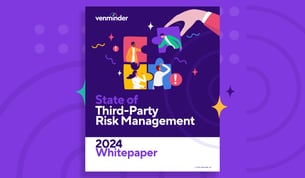
Venminder's State of Third-Party Risk Management 2024 whitepaper provides third-party risk management insight and industry statistics to help you make informed programs decisions. Learn how others are managing third-party risk.

Venminder is the industry's leading third-party risk management solution provider.
Leadership →
We're hiring! Explore career opportunities and learn more about Venminder culture.
Check out the select partners we aligned with to provide additional solutions and services.
Learn how to become a Venminder integration or referral partner.
See how Venminder can enable you to run an efficient third-party risk program.
Get in touch with a member of your team to discuss a question you may have.
Already a Venminder customer? Connect with the Customer Support Team.
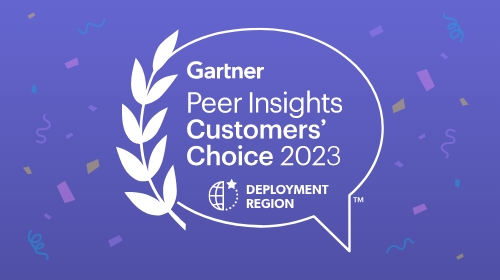
Read More →
Gain a 360-degree view of third-party risk by using our SaaS software to centralize, track, automate, assess and report on your vendors.
- New Vendor Onboarding
- Contract Management
- Risk Assessments
- Questionnaires
- Oversight Management
- Oversight Automation
- SLA Management
- Issue Management
- Advanced Workflows
- Business Unit Permissions
Venminder Exchange
- Integrations
Vendor Risk Assessments
Venminder's team of experts can review vendor controls and provide the following risk assessments.
- Initial Vetting Packages
- Financial Health Assessment
- SOC Assessment
- Business Continuity/Disaster Recovery Assessment
- Point-in-Time Cybersecurity Assessment
- Data Protection Assessment
- Information Security and Privacy Assessment
- Contract Compliance Assessment
- Regulatory Compliance and Operational Assessment
- CAIQ Assessment
- SIG Lite Assessment
Managed Services
Let us handle the manual labor of third-party risk management by collaborating with our experts to reduce the workload and mature your program. Overview Document Collection Policy/Program Template/Consulting Virtual Vendor Management Office Vendor Site Audit
Ongoing Monitoring
Let us handle the manual labor of third-party risk management by collaborating with our experts.
- Business Health Monitoring
- Cybersecurity Monitoring

As Venminder completes assessments for clients on new vendors, they are then made available inside the Venminder Exchange for you to preview scores and purchase as you need.

Learn more on how customers are using Venminder to transform their third-party risk management programs.
- Getting started
- Increase program efficiency
- Effectively mitigate vendor risks
- Reduce the due diligence workload
- Comply with regulations
- Drive collaboration across your org
Venminder is used by organizations of all sizes in all industries to mitigate vendor risk and streamline processes
- Financial Services
- Manufacturing
- Real Estate
We focus on the needs of our customers by working closely and creating a collaborative partnership
- What makes us different
- Customer success stories
- Quick implementation
- Commitment to customer experience
- Pricing packages
- Independent research
- Partners & Endorsements

Sample Vendor Risk Assessments
Venminder experts complete 30,000 vendor risk assessments annually. Download samples to see how outsourcing to Venminder can reduce your workload.

Trends, best practices and insights to keep you current in your knowledge of third-party risk.
- Infographics
- Industry Interviews
- Whitepapers
- Sample Work Products
Earn CPE credit and stay current on the latest best practices and trends in third-party risk management.
See Upcoming Webinars
On-Demand Webinars
Join a free community dedicated to third-party risk professionals where you can network with your peers.
- Join Community
Weekly Newsletter
Venminder samples.
Download samples of Venminder's vendor risk assessments and see how we can help reduce the workload.
- Download Samples
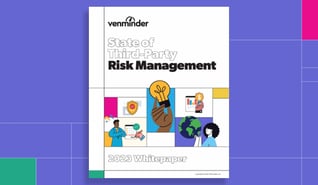
State of Third-Party Risk Management 2023!
Venminder's seventh annual whitepaper provides insight from a variety of surveyed individuals into how organizations manage third-party risk today.

Manage the complete vendor lifecycle - onboarding, ongoing management, offboarding.
Order due diligence assessments on your vendors that include qualified risk ratings and reviews.
View Packaging and Pricing ➔
Reduce the workload with customized outsourced services (eg: document collection).
Monitor for risks within cybersecurity, business health, financial viability and more.
Shorten the sales cycle by becoming due diligence ready for prospects and customers.
Access a free library of thousands of vendor risk assessments available for preview and purchase.
Download free samples ➔
infographic
Advantages, hurdles and best practices of vendor on-site visits.
The vendor on-site visit is one of the traditional due diligence standards in vendor oversight. The vendor types which warrant an on-site visit will vary across industries, but a best practice is to perform on-site visits on critical and high-risk vendors. To learn more best practices and tips for on-site visits, download our helpful infographic today.
Download the infographic for:
- 5 considerations to keep in mind
- The pros and cons of on-site visits
- Common hurdles and how to overcome them
- 7 best practices for when you're on-site
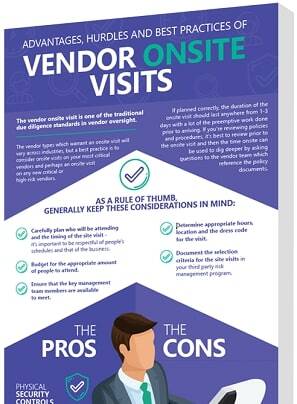
Download Now
- Capacity Building
- Collaboration
- Communication
- Field Building
- Funder Approach
- Outcomes & Impact
- RFPs & Competitions
- Sustainability
- Transparency
- Arts & Culture
- Civic Engagement
- Community Development
- Economy & Workforce
- Emergency & Disaster
- Environment
- Human Rights
- Peace & Conflict
- Science & Technology
- Candid Features
- Case Studies
- Curated Content
- Guided Reading
- Infographics
Conducting a Meaningful Site Visit
A site visit can be one of the most important tools you use, as a grantmaker, in determining your ultimate funding decisions. For example, an in-person look at a potential grantee’s activities can complement a grantee’s written proposal and give you a clearer picture of their request. In fact, site visits can be one of the most interesting parts of the grantmaking process.
What makes a site visit meaningful? Careful preparation, mutually understood goals, a willingness to see the event as part of an ongoing relationship. So how can you be a "good guest" while conducting a structured, but not stifling, site visit? Here grantmakers offer some helpful advice for:
"It's not surprising to feel a little nervous about site visits. One way to orient yourself is to put yourself in the shoes of the applicant and imagine how you'd like to be treated. Often, puzzles about what to say or how to say it will become immediately clear."
— A grantmaker recalling a first experience with site visits

Managing Your Role
Since the business of making grants primarily involves establishing a relationship between the grantor and the grantee, grantmakers often conduct site visits precisely to develop firsthand relationships with leaders and organizations in the communities and fields on which they focus. As such, a site visit can serve as an open-ended interview that allows you to ask pressing questions you may have and let potential grantees discuss the things they love to do. Talking at length and in depth with applicants about their work, and making certain they understand the fundamental purposes of your grant-making program, can also sometimes lead to exciting new ideas.
It can be a mistake, though, to think of a site visit as a discrete, one-time-only event. Site visits and one-to-one conversations are more likely to be continuing activities — at least with organizations directly involved in your program areas. Consequently, you may decide to make your first site visit to some organizations before you circulate a request for proposals, as a get-acquainted step, or as an element of your overall reconnaissance. Later, another visit may be part of your consideration of the group’s proposal. If you decide to award a grant, there are likely to be other visits — within reason — down the road, either to monitor the grant or maintain good relations.
Bear in mind that few organizations turn down a funder’s request for a meeting. They may be in the midst of their busiest season, rushing to prepare a proposal for another funder, or simply overwhelmed with work — they’ll probably still set aside two hours for you. As valuable as site visits can be, therefore, it’s important to make sure you’re not imposing on the organization’s time or distracting its staff. Remember: the organization is not likely to tell you — at least at first — that your request for a meeting comes at a bad time. You need to be alert and sensitive, and hope that at some point the group feels free to be more candid with you about its schedule.
Before You Visit
If the site visit is a first contact, do some homework. If you have not yet received a proposal from the organization, visit its Web site, if one exists, or research its area of work. This preparation allows you to use the time you spend with potential grantees efficiently, to ask pertinent, informed questions, and to understand what they’re trying to accomplish.
Even if the contact isn’t a new one, prepare yourself and the grantee before the visit. Be thoughtful and clear. For example, you might explain that you want to learn more about a particular aspect of the organization’s work. In any case, let them know how much time you have, and whether there are particular people or activities you would like to see.
Formulate some preliminary questions — but be careful of coming up with a long list. Narrow it down to the three most important ones, so as not to overwhelm your host. Notify the potential grantee of your questions ahead of time. You might also suggest that the organization send you an agenda of its own for the visit.
If possible, schedule site visits at times when you can observe some type of program activity. It helps to experience the work of the potential grantee firsthand.
While it can be helpful to conduct your visit with other staff from your foundation — the added perspective may be valuable — remember that having too many additional people can make it hard to have an informative, relaxed conversation.
Be aware that a site visit is a very important event to potential grantees. They will quite likely put a lot of energy into planning it and will hope to have your full attention. Difficulties in scheduling can create a misleading impression, as one grantmaker learned: "I remember a time when one of our team had to leave after half an hour. It wasn’t disrespectful; it was just someone juggling a tough working schedule. But it seemed as though perhaps we weren’t really that interested."
During the Visit
Begin by reminding people of the reason for your visit and about your role. You may have explained these points already, but nonprofits often play host to visitors, and may not remember what you told them. Be sure they understand that you’re there not only as an interested individual, but as your organization’s representative.
Since everyone's time is scarce, you may want to focus on what you most need to know to make a good grant, and on matters that call for the prospective grantee's impressions, interpretations, and personal reflection. In other words, the site visit is not usually the best time to bring up small, detailed matters that may require the applicant to do research or analysis. It is an opportunity to get to know the organization in a more personal way than is possible on paper
As the Visit Concludes
Don't forget to use the visit as an opportunity to expand your knowledge of the broader community or field. Ask applicants for suggestions about other organizations or activities that you should be looking at, or other people you should get to know.
Leave room for excitement: surprisingly good things can happen during a site visit. "I remember one visit," notes an experienced grantmaker, "when, after about an hour-and-a-half of talk and examination of the premises, the prospective grantee deferred going to another meeting so he could fill us in on his ideas for several different possible grants. It was a lively discussion, and I think curtailing it would have curtailed the making of the grant. You have to leave room for excitement."
And a final note. If the first one or two visits start off stiffly, don't worry. It takes more than an hour or two, and often more than a single visit, to establish the kind of trusting, open relationship in which a real exchange of ideas — the "excitement" — can take place.
Learning from Site Visits (Funding Community Organizing) Managing Expectations: Site Visits (Saying Yes / Saying No)
Takeaways are critical, bite-sized resources either excerpted from our guides or written by Candid Learning for Funders using the guide's research data or themes post-publication. Attribution is given if the takeaway is a quotation.
This takeaway was derived from Building Community Inside and Out .
Content type
Related content, your candid learning for funders.
- Registration
- Content Feeds
- About the Website
- About Candid Learning for Funders
- Journal Guidelines
Onsite Visits And Why They’re Essential
Before moving day, an onsite consultation can play a vital role in the success of a move. This onsite visit allows our movers to familiarize themselves with the unique aspects of your space and belongings. They are able to locate access points like elevators and stairways, and properly prepare to avoid any mishaps or delays on moving day.
In order to have a successful move, it is important for our expert movers to coordinate many details of the move, ensuring the move comes together seamlessly and efficiently. We believe so strongly in the importance of onsite visits that we offer this service for free, and we recommend it for every move we handle.
At FlatRate Moving we offer three methods for you to share the details about your move; A phone consultation, a virtual assessment, or an onsite visit. Our goal is to tailor our approach to your unique needs. Here is some information about the advantages of each method to help you determine which one suits your needs.
Phone Consultation
During a phone consultation, our experienced mover will discuss the specific details of your move. This includes the requirements and specific preferences you may have. This consultation gathers essential information about the move such as:
- Inventory List: Create a detailed inventory list of all the items you plan to move
- Special items that require extra care
- Specific services needed such as packing or storage
This type of method is good for small and simple moves. A small move is a move that includes a small apartment or studio moving minimal furniture between short distances. A phone consultation may not be effective in capturing the complexities of some moves. Anything beyond a small and simple move we recommend exploring other assessment options.
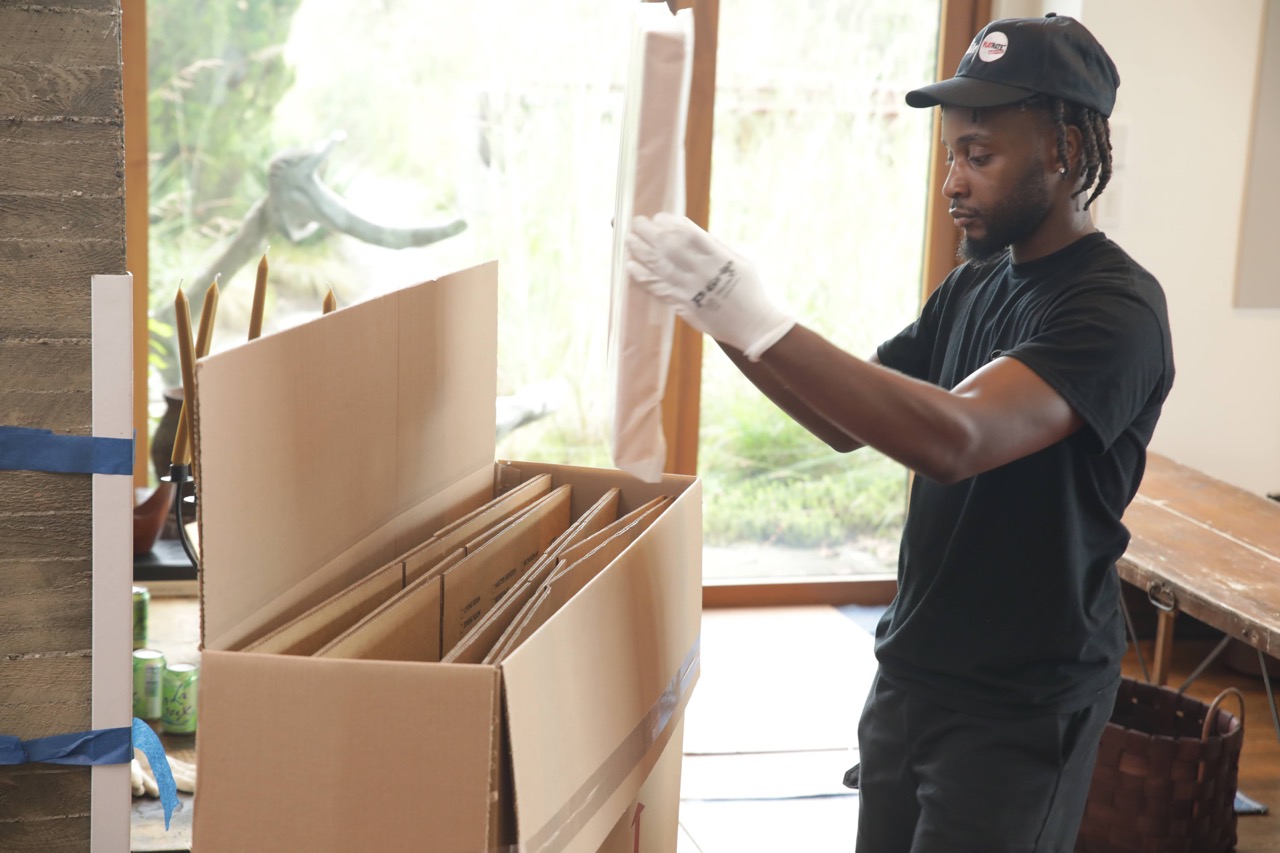
Virtual Consultation
Virtual consultations are a more in depth assessment than a phone call. These consultations are almost as effective as onsite visits, especially for small and straightforward moves. This method allows our moving experts to:
- Create a detailed inventory
- Identify high-value or special items requiring special handling
- Evaluate access points
- Understand specific packing and crating needs
In virtual consultations, it is hard to assess the size of your entrance, any elevators, hallway space, and the real size of furniture. This is why FlatRate Moving recommends an onsite visit for anything other than a small and simple move.
If you’ve never done a virtual consultation before, and/or want some tips and tricks on how to do one best, please read this blog article
Onsite Visit
When it comes to complex moves, an onsite assessment is highly recommended. During an onsite visit, a FlatRate Moving consultant will visit the location of your move and conduct a thorough and detailed evaluation. This includes:
- Creating an inventory list: To determine your guaranteed flat rate quote.
- Evaluating inventory items: To plan and prepare moving logistics.
- Estimating boxing requirements: Ensuring a safe and secure packing and transportation process.
- Assessing furniture treatment needs: Disassembly, reassembly and more.
- Measuring specific items: To ensure the proper manpower and moving materials are present.
- Evaluating entrance dimensions: This guarantees everything will safely fit through the door.
This assessment will allow for detailed and seamless planning and preparation for your move.
Table: Advantages of Phone Consultation, Virtual and On Site Visits:
Each consultation method is designed to ensure that your moving experience is curated perfectly to your moving needs, providing you with convenience and precision.
Our recommendation is to schedule an onsite visit – which is done for free at FlatRate Moving , however, we are experienced and fully prepared to work with any type of consultation method to guarantee a flawless moving experience.
Enter your phone number and we'll give you a call!
*invalid phone number

Onsite, On site, or On-site? (Helpful Examples)
“Onsite” has a few different spellings that we need to discuss. It works as one or two words, but it also seems to work as a hyphenated form. This article will explore all the rules you need to remember.
On site vs. On-site vs. Onsite
All three forms are correct. We can use “on-site” and “onsite” synonymously to describe a noun or verb as they are both used as adjectives and adverbs. “On site” is a compound noun that allows us to use the “on” preposition with the noun “site.”
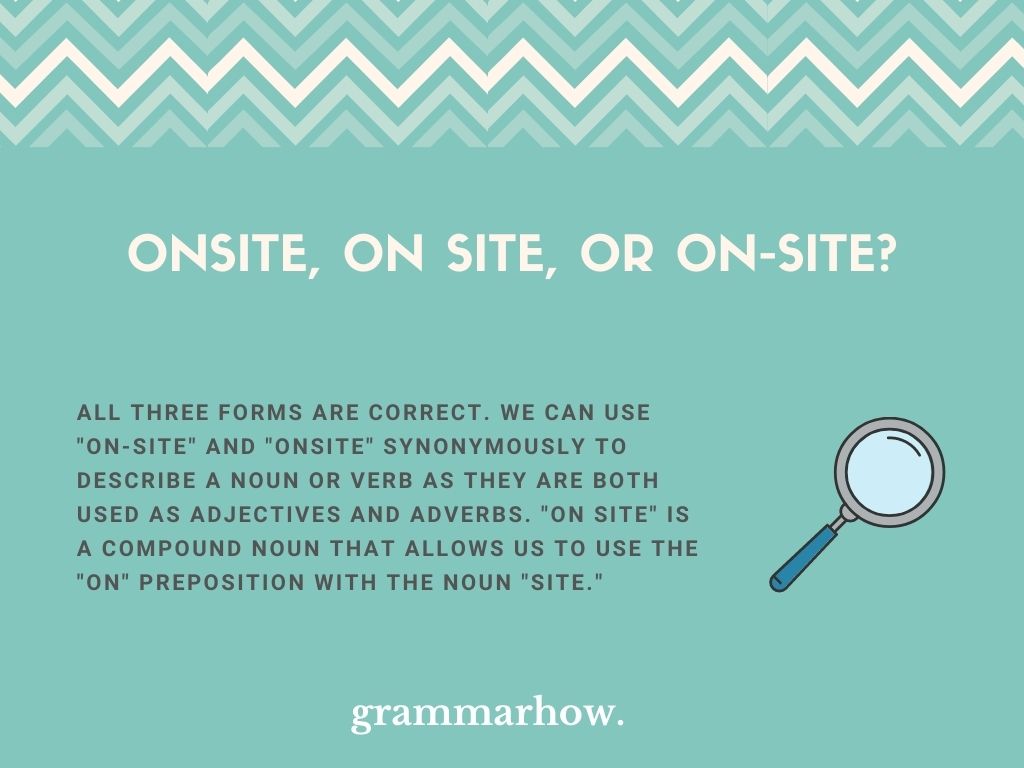
According to Google Ngram Viewer , “on-site” is the most popular of the three, but there isn’t much in it. “On site” is the second most popular choice, and the grouped variation of “onsite” is third.
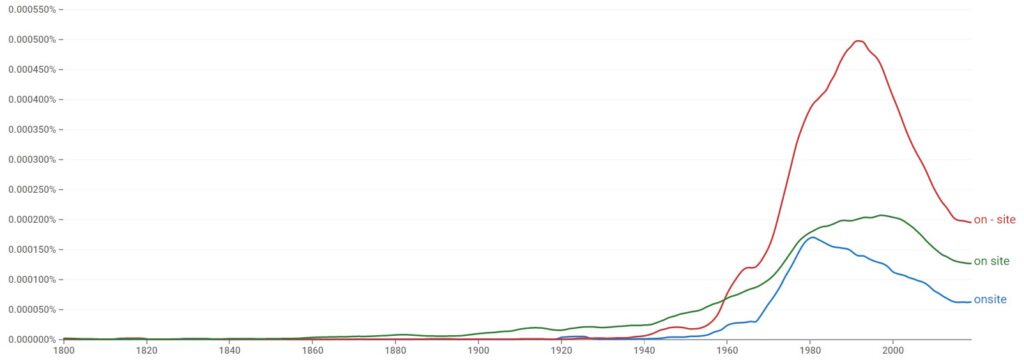
The Cambridge Dictionary and The Oxford Dictionary offer entries for all three forms. “Onsite” and “on-site” are the most obvious ones. They are both defined clearly as adjectives and adverbs, showing that they can be grouped or hyphenated.
While there isn’t a direct entry for “on site” as two words, there are no particular reasons why it can’t work. In fact, if you search “on site” as two words, you are redirected to the “site” entry page, which shows you how the preposition interacts with the noun.
Is “Onsite” One Word?
“Onsite” works best as one word. We can use it as an adjective or adverb when it’s used in this way. It’s a great way to show that something is happening on a particular site, though it works best to describe a noun rather than as a standalone descriptor.
These examples should give you all the information you need about it:
- I have a few onsite details that should help us understand more about this.
- There’s an onsite protest about wages, and I don’t think it’s wise for you to go out there and see those people right now.
- Let’s not get the onsite facilities out of order by being stupid! We need these for a while yet.
- It’s not all about the onsite issues, but it’s definitely something that we should be able to work through together.
Is “On site” Two Words?
“On site” works as two words when it refers to the noun form. It’s more common to see it as two separate words when we want to make it clearer that something is specifically on a site. We use “on” as a preposition in this case to keep the words separate.
These examples should clear a few things up:
- If he isn’t on site by the end of the day , then I don’t want anything more to do with him.
- There are many places on site that are worth checking out if you have the time.
- We have plenty of things on site that should give you a hand with this.
- It’s not on site because we didn’t see much point in having it there!
Is “On-site” Hyphenated?
“On-site” is hyphenated as an adjective or adverb. It’s mainly used in its hyphenated form as an adjective because this allows us to stay closer to English rules. We typically hyphenate compound adjectives when they modify the same noun in a sentence.
AP Stylebook guidelines allow us to use hyphens when working with compound adjectives. If more than one word needs to modify the same noun, the hyphen is what we use to link the two words with each other to help us understand them.
Here are some examples that show you the hyphenated form.
- They have a few on-site facilities that would be a good help for this.
- I don’t like any of the on-site workers right now, and I think it’s better if we let most of them go.
- They’re not on-site, and I need to find a group of people who are willing to get this job done quickly for me.
- Can you find out where the on-site records are kept? I’d like to find out whether we can continue working this way.
Is “Site” Capitalized In The Word “On-Site”?
Generally, there is no reason to capitalize both parts of the hyphenated “on-site.” It does not require capitalization unless it starts a sentence, which means only “On” would need a capital letter.
However, if you write it as part of a title, you might find it works to capitalize it to be “On-Site.” This will help it to stay more true to the rest of your title style.

Martin holds a Master’s degree in Finance and International Business. He has six years of experience in professional communication with clients, executives, and colleagues. Furthermore, he has teaching experience from Aarhus University. Martin has been featured as an expert in communication and teaching on Forbes and Shopify. Read more about Martin here .
- Jobsite or Job Site – Which Spelling Is Correct?
- High quality or High-quality? (Helpful Examples)
- Newfound or New-Found or New Found? (UK vs. US)
- Much needed or Much-needed? (Hyphen Rule Explained)
On-Site Visit
- COVID-19 Updates
- At A Glance
- Board of Directors
- Board of Delegates
- ABET Councils
- Accreditation Commissions
- Bylaws, Constitution and Rules of Procedure
- Licensure, Registration & Certification
- Diversity, Equity & Inclusion
- Senior Leadership
- Publications
- Why ABET Accreditation Matters
- What Programs Does ABET Accredit?
- Program Eligibility Requirements
- Accreditation Step by Step
- Assessment Planning
- Request for Evaluation (RFE)
- Changes During the Period of Accreditation
- Decision & Notification
- Accreditation Outside the U.S.
- Reaccreditation
- Additional Resources
- ABET-Accredited Logos
- Self-Study Templates
- Accreditation Changes
- Fees For Programs Outside The U.S.
- Find Programs
- Is Your Program Recognized?
- Memoranda of Understanding
- Substantial Equivalency
- Engineering Credentials Evaluation International
- Member Societies
- Why Become a Program Evaluator?
- What is Involved?
- How to Become a Program Evaluator
- Society Requirements for Program Evaluator Candidates
- Accessing Brightspace
- Current Program Evaluators
- ABET Symposium
- July Commission Meeting
- Visa Letters
- Cancellation Policy
An on-site visit allows the assigned accreditation review team to assess factors that cannot be adequately described in written form. On-site visits are conducted for an initial accreditation review, for a regularly scheduled comprehensive re-accreditation review, and for an interim visit review.
The typical minimum review team size is three members; one team chair and two program evaluators for a single program visit. For a multiple-program visit, a review team typically consists of one team chair and one program evaluator for each program. In certain cases counts may be adjusted. For visits involving a large number of programs or a single program delivered at multiple locations, a co-team chair may be assigned to assist the team chair.
Visit Schedule & Activities
Typically, for programs located in the U.S, an on-site visit is scheduled between September and December, and lasts three days, usually Sunday through Tuesday. On-site visits to programs outside the U.S. may have a different visit schedule to accommodate team travel time, local culture, and customs.
During initial or comprehensive on-site visits the review team will:
- Verify the information provided in the Self-Study Report.
- Investigate issues identified during the review of the Self-Study Report.
- Interview students, faculty members, administrators, and staff.
- Review display materials.
- Visit classrooms, labs, and other key facilities.
- Determine compliance with the applicable ABET criteria and policies.
- Assist each program under review in recognizing its strong and weak points.
- Share suggestions for improvements or exchange best practices.
- Conduct an exit meeting to convey the team’s findings. This meeting is attended by the institution’s chief executive officer and any administrators s/he chooses. During the briefing, the team chair provides a Program Audit Form (PAF) for each program reviewed. The PAF briefly lists the preliminary findings along with an explanation of the seven-day period in which the programs can respond to any errors of fact in the oral statement or on a PAF.
Display Materials
Each program is asked to gather a variety of display materials that will assist the review team in its evaluation, including:
- Course syllabi
- Student work, including sample assignments, exams—ranging in quality from excellent through poor
- Assessment materials
Additional specific display materials may be requested by the review team. Programs located in countries where English is not the native language should be prepared to provide English translations for some displayed materials. Please check with the team chair assigned to your program regarding items that should be translated.
In some instances, a review team may include observers, who are individuals learning about the ABET accreditation process. Observers can be program evaluator trainees, members of licensure or registration boards, or representatives from our international partnerships. The inclusion of observers on any visit is at the discretion of ABET Headquarters, the team chair, and the institution being visited.
Interim Review Visits
An Interim Visit (IV) Review also requires an on-site visit. However, IV reviews only focus on shortcomings identified during the previous review. The review team will tailor its on-site activities based on the shortcomings from the previous review.
Welcome to the new ABET website. We hope you enjoy your experience. We are making it better everyday.
- Risk Management
- Vendor Management
- Compliance Management
- Findings Management
- Lending Compliance
- Credit Unions
- Mortgage Lenders
- Wealth/Investment Management
- Resources Hub
- Nsight Blog
- Regulatory Pulse
- Ncast Podcast
- Nsider Community
- Partnerships
Due Diligence 101: Are On-Site Visits Required?

How do you conduct an on-site third-party vendor review? It’s a hot topic at conferences and online. It’s also the wrong question. Instead of asking how to conduct an on-site review, bankers should be asking if they even need to conduct an on-site third-party vendor review. That’s because the answer in a large number of cases is no. An on-site third-party vendor review is often unnecessary and a waste of time and money.
Does Guidance Require On-Site Visits of Third-Party Vendors?
Let’s start with guidance on the subject. There is very little guidance requiring on-site due diligence. It’s peppered with words like “may” or “consider.” Examiners might ask if on-site visits are conducted, but that doesn’t necessarily mean they are required.
The FDIC "Guidance for Managing Third Party Risk" makes no specific mention of on-site visits. The agency’s Compliance Examination Manual mentions it briefly: “Review the adequacy and adherence to the third party’s policies relating to internal controls and security issues. This practice may also include performing on-site quality assurance reviews, targeting adherence to specified policies and procedures (e.g., visiting customer call centers to observe and verify sales, customer service, collection call procedures, and listening to verification recordings).”
The OCC’s "Bulletin 2013-29" states “On-site visits may be useful to understand fully the third party's operations and capacity. If the bank uncovers information that warrants additional scrutiny, it should broaden the scope or assessment methods of the due diligence as needed…Regular on site visits may be useful to understand fully the third party's operations and ongoing ability to meet contract requirements... In addition, bank management may consider on-site visits, reference checks, and inquiries with industry groups and peer institutions.” The OCC’s Supplemental Examination Procedures for Risk Management of Third-Party Relationships notes “Determine whether on-site visits are performed for a third party involved in critical activities. Analyze whether someone with the necessary authority and expertise conducts the visits and how information gathered during the visits is used for ongoing monitoring purposes.”
Fed guidance notes “Financial institutions should ensure that risk management processes include triggers to escalate oversight and monitoring when service providers are failing to meet performance, compliance, control, or viability expectations. These procedures should include more frequent and stringent monitoring and follow-up on identified issues, on-site control reviews, and when an institution should exercise its right to audit a service provider's adherence to the terms of the agreement.”
NCUA’s Third Party Relationships Questionnaire doesn’t mention on-site visits at all.
The FFIEC discusses the possibility of on-site visits for managed service security providers (MSSP) in its Booklet for Outsourcing Technology Services : “Management should consider performing an onsite visitation to determine if the servicer has the appropriate experience and control environment to meet the FI's needs, how long the MSSP has been in business, the MSSP's staffing, the MSSP's incident response methodology, etc. Periodic review of the MSSP's processes, infrastructure, and control environment through offsite reviews of documentation and onsite visitations.”
The Limited Value of Third-Party Site Visits
Unless you are sending an auditor or someone else who is specially trained, the value of an on-site visit is limited. You’ll be able to confirm that the company and its offices exist. You might be able to observe if some policies and procedures are actually followed. You’ll probably meet some nice people who will take you out to dinner. But chances are you’re not going to make a huge discovery. And there are a lot of less expensive and time-consuming ways to confirm that a company exists and employs real people. While it’s easy in this day to pose as a company with a fake email address and website, it’s also easy to uncover frauds by checking in with peers and trade associations. Checking references is good due diligence. Some financial institutions conduct a site visit every time they spend more than a fixed dollar amount, but that’s a misleading parameter. It’s all about how critical a vendor is and how much risk they present to your financial institution. You may employ a relatively inexpensive marketing company and that company has access to a great deal of sensitive data under GLBA. Your financial institution also has an expensive contract for naming rights to a local stadium. I’d be far more concerned about the small firm with access to sensitive data. They pose a much greater risk.
Vendor Risk Countdown: Top 10 Risks Third-Party Vendors Pose to Your Financial Institution
When a visit might be worthwhile.
There are some times when a vendor visit is worthwhile.
- Signing with a critical vendor that’s new to the market. If you’re doing business with a new critical vendor, it can be worthwhile to check in on it to understand its operations.
- A new critical vendor can’t provide all the due diligence documents you need. If a company doesn’t yet have an SSAE 18 or the financial info you need, it might be worth the trip.
- The vendor is having issues. If you’re disappointed in a vendor’s performance, it might be worthwhile to take a look around, if only to make it clear how serious you are about your concerns.
Don’t waste time and money visiting every vendor when a deep dive into due diligence documentation will do the job just as well (and is necessary anyway). Save on-site vendor visits for when there is something important that can’t be uncovered with research from a desk. I can’t find anything in the guidance to justify the effort or expense.
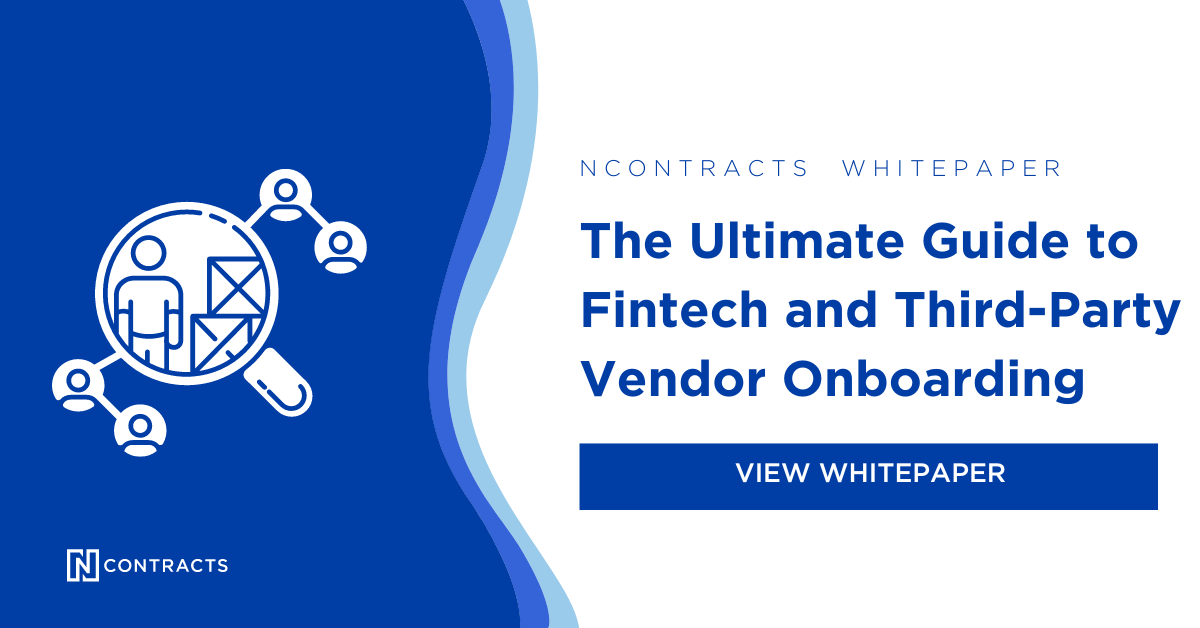
Subscribe to the Nsight Blog
You may also like.

Laws vs. Regulations vs. Guidance: What's the Difference?

What’s The Difference Between Business Continuity Management (BCM) And Pandemic Planning?

Misinterpreted Cyber Guidance & 4 Tips for Avoiding the Same Mistake

The Art of the Customer Visit: How to Plan One + Why You Should
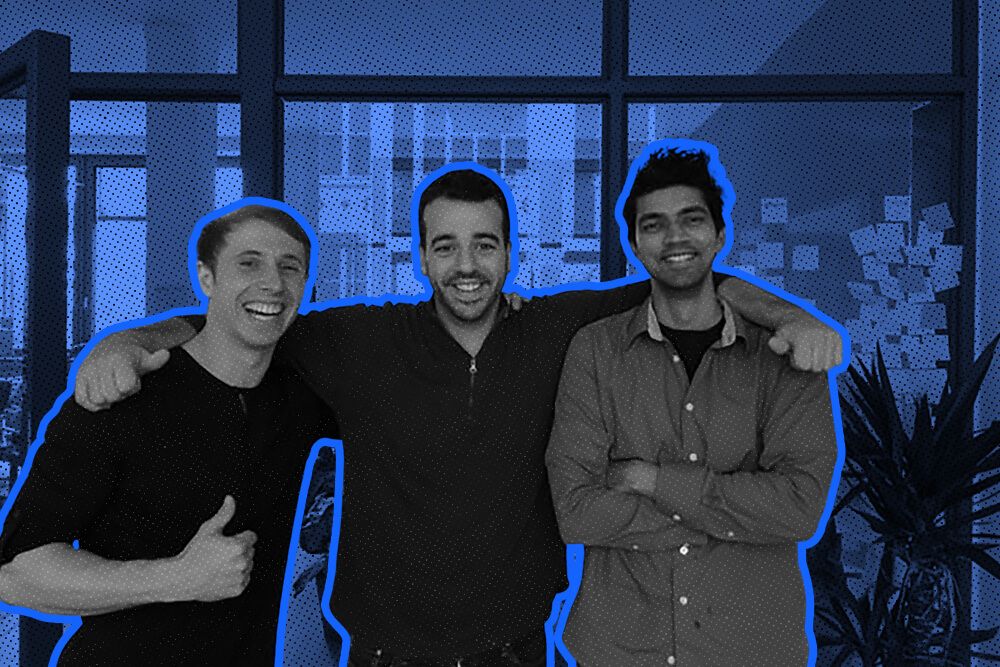
When was the last time you visited a customer? Customer visits might seem extravagant and unnecessary on the surface.
Why not just get on a phone call or Zoom meeting? Or follow up with them via email? You could just send them a survey, or even dig into your product analytics to surface insights.
That said, if I’m talking to another entrepreneur and say something like, "It's super crucial you physically visit your customers", they all look at me as if I just said the most obvious thing in the universe.
Visiting customers is like working out or eating healthy: everybody knows they should do it, but very few people actually do.
And we’re not excluding ourselves here: We launched Close in January of 2013, but our first customer visit was more than a year later!
Some businesses put off visiting customers because it takes time, and it’s easy to push down on your long to-do list. Or, it may seem more urgent to focus on getting new customers to sign on, rather than visiting existing customers.
If this sounds like you, let’s discuss the benefits of visiting your customers, and how you can set up successful customer visits.
What Are the Benefits of Visiting Your Customers in Person?
It’s true: COVID has permanently altered the way B2B sales works. Studies by McKinsey show that companies have reduced their in-person efforts as a go-to-market strategy by more than 50 percent since the pandemic started.
That said, a decent number of B2B buyers still prefer in-person contact during the customer journey.
And this is exactly where the opportunity lies—fewer companies are vying for your customer’s attention in person. This opens the playing field for your company to perform more customer visits.
And trust me—it’s worth the effort. Here's a quick rundown of the value we got from our first customer visits.
Motivate Your Team to Serve Customers Better
Seeing real people use your product is incredibly inspiring. It energizes you. It recharges your batteries. It gives you a visceral sense of how your work actually impacts the life of your users, rather than just an intellectual understanding. It's like pouring gasoline on the fire that fuels your engine.
Everybody on your team—from the CEO to the intern—should visit a customer, for this reason alone.
It is different from hearing customers tell you how much they love your product or how great they think it is. You just have to experience customer satisfaction happening in real-time. You need to see real human beings depending on what you built. You need to witness how your product helps them to operate better, to be better at what they are doing.
The impact you make on other people's lives is a much stronger driver than any number on a spreadsheet can ever be. Do not underestimate how much this affects you. It's powerful.
Build Better Customer Relationships
Meeting someone in person adds another dimension to your relationship with your customer. You can do a lot of relationship-building via email, chat, phone, and Zoom, but nothing has the same effect as meeting someone in person. It creates a human bond between the two of you.
Jason Lemkin of SaaStr says he never lost a customer whom he had personally visited while he was CEO of EchoSign. Spending time with your customers transforms a transactional relationship into a partnership. It builds empathy on both sides, which ultimately leads to better business.
In-person customer visits are one of the best ways to build customer intimacy . It deepens the commitment on both sides. If one of the people we met needs help one day, we'll be more eager to support them. And I'm pretty sure they'll be more forgiving if there's ever an issue with Close and be more loyal to our product.
Get In-depth Product Feedback on the Customer Experience
Your customers are more than the sum of all their clicks on your product. Yes, you might be monitoring product usage and reading all the feedback people send you via email or even tell you on the phone, but you're missing a lot of crucial context if you can't see your customers using your product within their work environment.
- How exactly are they using your product?
- What's happening around them?
- What else is on their screen?
- What's competing for their attention?
- What's their workspace like?
When you visit your customers, you get to see the environment in which they use your software. You experience your product embedded into a user's workday and get a sense of the entire puzzle, rather than just a single piece of it.
And it's little things, like...
- What kind of headsets /chairs/desks are they using?
- What other software/apps are they using during their day?
- Which little hacks did they come up with to make them more productive and efficient?
- What makes them smile, and what makes them frown when interacting with your web or mobile app ?
It just gives you a better picture of what's working and what's not.
Here’s a real example: during one customer visit, we saw that the customer was using a TV to display our reporting in Close . But at the time, our reporting page wasn’t optimized for full-screen display—it looked crappy.
I remembered that one of our engineers had worked on a quick fix that would make this look better, but we had never released it. I sent a message to the team, and within an hour, this feature was released by our VP of Engineering, Phil Freo . It looked fantastic, and our customers loved it.
While visiting customers, you can gather more in-depth feedback about how they’re using your product and where they would like to see improvements in the customer experience. Product managers can then use this information to build out improvements.
Find Opportunities to Upsell
Years ago, during one customer visit, we found the customer was on a basic plan that didn’t include a specific feature. Instead, they were using a third-party provider to get this feature for their sales team.
Talking with the founder, we faced some resistance to upgrading their plan. But we gained an internal champion during that customer visit by chatting with the sales team manager. We gave him everything he needed to make the transition happen, and they soon upgraded their plan to start using this feature again.
Visiting customers in Germany in 2015
This is the power of in-person visits—not only did the extra revenue help us, but by upgrading their plan, the customer’s success with our product was significantly increased.
Create New Case Studies and Customer Stories
Using case studies and real-life examples of how your customers use your product is an excellent digital marketing strategy and one that will help build trust in your brand.
When planning customer visits, think about the customers you may want to interview for video testimonials or case studies on your website. Having these real customer stories also helps build better marketing alignment with your ideal customers and their needs.
All of these are examples of the kinds of benefits you can get from visiting your customers. You can't predict which benefits precisely you'll get—but you will always get value from a customer visit!
Get Your Copy of Talk to Your Customers →
How to Plan a Client Visit That Boosts Customer Loyalty in 7 Steps
By now, you should be sufficiently motivated to actually visit your customers. But what do you say and do? How do you get the most value out of these visits? How do you prepare for them? How do you wrap them up? How do you get started when you visit their office?
1. Identify Which Customers to Visit
Whether you have 10 customers or 10,000, it’s probably not feasible to visit everyone. So, which customers should you visit?
To start, make a list of the customers who already have a good rapport with you—your partners, advocates, and overall best customers.
Next, include customers who are using your product or purchasing from you on a regular basis. Learning about how they use your products and services, or why they keep coming back to you, will be great for your team.
Finally, make sure to include the customers who consistently give you critical feedback. These customers are already pushing your team to do better, and they will likely have super valuable insights to share with you when you visit in person.
2. Decide Who You’re Meeting With
Once you know which companies you’ll visit, decide which individuals inside the company you’ll need to meet with.
First of all, you set up a meeting with the founders or CEO. That's the person you'll be officially meeting. But it's not necessarily the person you'll spend most of the time with.
For SaaS companies, focus on the person managing the team that's using your product, as well as the end-users. If you’re a service-based business, talk to the people who are mainly affected by using your services.
The Close team visiting customers in Ottawa, Canada, 2014
3. Spend Time Getting to Know the Business Beforehand
Just like when prospecting, spend time doing research before the meeting—whether that’s on social media sites like LinkedIn, on the company’s website, or in B2B databases like Crunchbase.
When you walk into that client visit, you should know exactly who you’re talking to, what kind of business they are, which customers they serve, and how your product or service fits into that workflow.
4. Prepare and Share an Agenda
Having a clear agenda for your customer visit is essential to get the most out of the time you spend with your customers.
Start by setting out the agenda for your main meetings with the C-suite and with the managers of the teams that use your product. Set up talking points: such as updates to your product pricing, or upcoming feature launches in your product. Also, leave room in the agenda for their team to add any questions or comments. Leave a clear space for them to give you feedback.
Once your customer visit agenda is prepared, share it with their team. Let them have editing access so they can include their ideas. Make sure that expectations between you and your customer are aligned before you start asking them a lot of questions. Create a setting that encourages them to discuss and share their concerns openly.
Also, make sure to discuss confidentiality. If you plan to report back to your team after your customer visit, explicitly ask them if they're fine with you sharing their business processes, revenue numbers, etc, with your team. (If not, that's fine too—you can still share the learnings, without actual specifics, with your team.)
That way, both teams will be ready to get started when the day comes.
5. Learn About the Customer Experience in Real Time
So, the day of your customer visit has finally arrived! Start by talking in general, broad terms about their business and your business. Then, progress to more specific topics and product use cases.
Be both a student and a mentor. Learn as much as you can about your customers, and look for opportunities to help them. Learn about their workflows, and your product fits into those workflows.
Here are some questions you might ask during a client visit:
- How often do you use our product?
- Which team members use our product the most? How often do they use it?
- Are there secondary users that only use our product occasionally? If so, for what? How often?
- What are your business goals?
- How do you implement our product in your daily workflow?
- What bugs have you encountered?
- What features are you missing within our product?
- What do you like most about our product?
- What do you hate about our product? Which limitations do you find particularly frustrating?
- Which metrics does your team track within our product? (Or which KPIs does our product impact for your team?)
- If our product ceased to exist tomorrow, what alternatives would you consider to replace us?
- Are there any trends or changes in the industry that could affect the way you use our product in the future?
These questions and others like them will give you a clearer picture of how your customers use your product, and how it impacts their business.
The Close team doing a customer visit
6. Ask for and Give Referrals
Visiting customers is a great opportunity to get referrals . And to refer them to others as well. Don't just limit referrals to potential customers—any reason to put them in touch with other people is fair game, as long as you can see potential value for both parties.
Sometimes we see companies serving the same audience with complementary services—that's potential for a co-marketing initiative. If you introduce two happy customers to each other, and they collaborate together, and both get a ton of value out of it, you generate a lot of goodwill, and oftentimes very vocal brand advocates.
If you have a partner program set up, try to see if the customer you’re visiting would be a good candidate for that program, and help them understand how it works and the benefits they could get.
7. Create a Customer Visit Report for Your Team
If you do conduct a customer visit, make sure to document your learnings and take note of memorable moments. Then, you can share these insights with your team.
It's important that all the insights you gain during a customer visit actually become organizational knowledge—otherwise, your customer visits are basically useless.
So, set up a structured customer visit report that your team can peruse and learn from, both now and in the future. Inside this document, note specific items that will be of interest to the different teams in your company—for example, product feedback that your product managers may want to look at, customer journey insights that the marketing team should keep in mind, or product knowledge gaps that the customer success team may need to address.
To make sure everyone in the company benefits from customer visits, we try to share some pictures or highlights from our customer visits in Slack, and then during our weekly team meeting, a team member might give a quick 2-minute summary of their customer visit.
How Often Should You Plan Customer Visits?
There's no one-size-fits-all formula. It depends on your startup, but in general: you should meet them more often than you're meeting them now.
Jason Lemkin recommends every co-founder, CEO, and Customer Success Manager should meet on-site with five customers a month.
Being able to see the environment in which your customers use your product, the atmosphere at their workplace, and talking with the people who use your product daily is always an insightful experience.
Customer visits have been a crucial market research method for traditional businesses for many decades—but they're even more crucial for startups and SMBs . Your most powerful asset when you're in a market with established, large companies is your ability to understand your customers better and focus on their needs better than a large corporation can.
Michael Seibel, Managing Director at Y Combinator, said : "If you look around the startup ecosystem, you can find too many founders who believe that famous investors + lots of employees = winning. I bet most of our VC-backed competitors feel this way, and you can use this to defeat them (they aren't talking to customers nearly enough).”
Want more insights on talking to your customers? Get my book and learn more about building customer intimacy.

More articles from The Close Blog

Discover our latest free sales tools powered by AI
Learn from the sales pros with our free sales guides.

An official website of the United States government.
Here’s how you know
The .gov means it’s official. Federal government websites often end in .gov or .mil. Before sharing sensitive information, make sure you’re on a federal government site.
The site is secure. The https:// ensures that you are connecting to the official website and that any information you provide is encrypted and transmitted securely.
Occupational Safety and Health Administration
- 中文(简体) (Chinese-Simplified)
- 繁體中文 (Chinese-Traditional)
- Kreyòl ayisyen (Haitian Creole)
- 한국어 (Korean)
- Español (Spanish)
- Filipino/Tagalog
- Tiếng Việt (Vietnamese)
- OSHA's On-Site Consultation
What Happens During an On-Site Consultation Visit?
Because consultation is a voluntary activity, you must request it. To make a request, locate your state's Consultation Program's contact information using our OSHA's Consultation Directory . The consultant will discuss your specific needs with you and set up a visit date based on the priority assigned to your request, your work schedule, and the time needed for the consultant to adequately prepare to serve you. OSHA encourages a complete review of your firm's safety and health situation; however, if you wish you may limit the visit to one or more specific problems.
The On-Site Consultants Will
- Help you recognize hazards in your workplace.
- Suggest general approaches or options for solving a safety or health problem.
- Identify kinds of help available if you need further assistance.
- Provide you a written report summarizing findings.
- Assist you to develop or maintain an effective safety and health programs.
- Provide training and education for you and your employees.
The On-Site Consultants Will Not
- Issue citations or propose penalties for violations of OSHA standards.
- Report possible violations to OSHA enforcement staff.
- Guarantee that your workplace will "pass" an OSHA inspection.
Opening Conference
When the consultant arrives at your worksite for the scheduled visit, he or she will first meet with you in an opening conference to briefly review the consultant's role and the obligation you incur as an employer.
Walk Through
Together, you and the consultant will examine conditions in your workplace. OSHA strongly encourages maximum employee participation in the walk-through. Better informed and more alert employees can more easily work with you to identify and correct potential injury and illness hazards in your workplace. Talking with employees during the walk-through helps the consultant identify and judge the nature and extent of specific hazards.
The consultant will study your entire workplace or the specific operations you designate and discuss the applicable OSHA standards. Consultants also will point out other safety or health risks that might not be cited under OSHA standards, but nevertheless may pose safety or health risks to your employees. They may suggest and even provide other measures such as self-inspection and safety and health training you and your employees can use to prevent future hazardous situations.
A comprehensive consultation includes:
- An appraisal of all mechanical and environmental hazards and physical work practices.
- An appraisal of the present safety and health programs or establishment of one.
- A conference with management on findings.
- A written report of recommendations and agreements.
- Training and assistance with implementing recommendations.
Closing Conference
The consultant will then review detailed findings with you in a closing conference. You will learn not only what you need to improve, but also what you are doing right. At that time you can discuss problems, possible solutions and abatement periods to eliminate or control any serious hazards identified during the walk-through. In rare instances, the consultant may find an "imminent danger" situation during the walk-through. If so, you must take immediate action to protect all employees. In certain other situations that would be judged a "serious violation" under OSHA criteria, you and the consultant are required to develop and agree to a reasonable plan and schedule to eliminate or control that hazard. The consultants will offer general approaches and options to you. They may also suggest other sources for technical help.
Abatement and Follow Through
Following the closing conference, the consultant will send you a detailed written report explaining the findings and confirming any abatement periods agreed upon. Consultants may also contact you from time to time to check your progress. You, of course, may always contact them for assistance. Ultimately, OSHA requires hazard abatement so that each consultation visit achieves its objective -- effective employee protection. If you fail to eliminate or control identified serious hazards (or an imminent danger) according to the plan and within the limits agreed upon or an agreed-upon extension, the situation must be referred from consultation to an OSHA enforcement office for appropriate action. This has rarely occurred in the past.
- EUR (€)
- GBP (£)
- Contact us

- Currency :
- US Dollar Euro Pound Sterling Russian Ruble Australian Dollar Canadian Dollar Swiss Franc Danish Krone Japanese Yen Norwegian Krone Swedish Krona
- Toll Free 0800 011 2023
- US and Canada United Kingdom Australia Brazil Netherlands Russia Sweden
- Tours by Region Moscow Saint Petersburg Golden Ring Lake Baikal Murmansk Siberia & Far East Sochi & Southern Russia Amsterdam Berlin Copenhagen Gdansk Georgia Helsinki Kaliningrad Kamchatka Karelia Kazan Klaipeda Nizhny Novgorod Northern Europe Oslo Perm Riga Ryazan Stockholm Tallinn Ulan-Ude Veliky Novgorod Vilnius Vladivostok Volgograd Yakutia Yekaterinburg
- Why Choose our Day Tours
- One Day Tours Two Days Tours Three Day Tours
- About Russian tours Private vs Group Tours
- Tours by Region Moscow & St.Peterburg Moscow Saint Petersburg Golden Ring Lake Baikal Trans-Siberian Siberia & Far East Altai Kaliningrad Kamchatka Karelia Kazan Perm Veliky Novgorod Yakutia Yekaterinburg
- Tour Types Small Group Tours Private Tour Theme Tour
- Moscow events St. Petersburg events Events archive
- Events by type Ballet Opera Concert Show All types
- Top theaters Bolshoi theatre - Historic Stage Bolshoi theatre - Small Stage Mariinsky Theater Mariinsky Theatre - Mariinsky II Mikhailovsky Theater
- Direction Moscow - St.Petersburg St. Petersburg - Moscow
- Ships MS Rostropovich MS Volga Dream MS Anton Chekhov MS General Lavrinenkov MS Georgy Chicherin MS Ivan Bunin MS Konstantin Fedin MS Konstantin Korotkov MS Kronshtadt MS Maxim Gorky MS Nikolay Chernyshevsky MS Nizhny Novgorod MS Rachmaninoff MS River Victoria MS Scenic Tsar MS Tikhy Don (MS Alexander Borodin) MS Vasiliy Kandinsky MS Zosima Shashkov Mustai Karim
- Russian Visa Invitation
- Moscow The Kremlin Red Square Golden Ring Tverskaya Street Grand Kremlin Palace (The Kremlin) Christ the Savior Novodevichiy Convent Moscow Subway The Bolshoi Theater Armoury Chamber (The Kremlin) St. Basil's Cathedral The Pushkin Museum of Fine Arts Yury Gagarin Cosmonauts training center
- Saint Petersburg Hermitage Museum Peterhof Catherine's Palace (Tsarskoe Selo) Pavlovsk St. Isaac Cathedral Peter and Paul Fortress Nevsky Prospect Yusupov Palace Savior on Blood Amber room Bronze Horseman (Senate square) Hermitage Theatre Kazansky Cathedral Kronstadt Palace Square Spit of the Vasilievsky Island
- 1/7th of the World Volga River Siberia Baikal Kazan Sochi Smolensk Nizhny Novgorod Kaliningrad Ulyanovsk Verkhoturova Island
- uVisitRussia Why travel with UVisitRussia Customers' Testimonials Contact details Cancellations & Changes
- Russian Travel News
- Russian travel advice Advices while packing Advices while travelling
Tour of famous Moscow Metro. Explore the Underground World! (2 hours)
- Add to wishlist
On this tour you take in some of Moscow's most important and highly decorated stations. Carrying up to 7 million passengers a day and covering almost the entire city, the Moscow Metro is one of the most extensive mass transit systems in the world. It's famous for the fine examples of social-realism which decorate many of its stations.
Visit some of the most important stations and get the chance to admire spectacular baroque-style ceilings, marble statues, busts of Communist heroes, stained glass windows, and ceiling mosaics depicting the bright Soviet future. Visit the most remarkable stations like Komsomolskaya, Kurskaya, Kievskaya and others, with the experienced guide who will bring you a full insight into their fascinating history.
- Tour of Moscow's Metro system visiting beautifully decorated key stations on the network.
- System that carries more than 7 million passengers per day
- Views of the most opulently designed tunnels & platforms
- Significance to the country—known as the “People's Palace”
- History & stories relayed by an expert local guide
If you wonder why the Moscow metro is considered one the most beautiful in the world, this tour is made for you!
Important info
Ask a travel expert.
- Professional English-speaking guide assistance. Other languages upon request (additional charge may apply)
- Hotel pick-up and drop-off
- Personal expenses
- Gratuities (optional)
- Food and drinks
- Confirmation will be received at time of booking
- Children must be accompanied by an adult
Departure and return point: nearest metro station to your central Moscow hotel
Departure time: flexible
Sights included in program

Thanks ! We will reply you in less than 24 hours (usually within 1-2 hours) .
Our flexible payment options allow you to pay 20% of a deposit first and the remaining 80% in 14 days prior to your tour date - payment can be done both online or over the phone. This gives you the peace of mind knowing your spaces are booked on the tours and that you do not miss out on making the most of your time in Russia.
Also you get the best, top-rated and most experienced and knowledgeable hand-picked tour guide appointed on a priority basis. In our experience, exceptional travel experiences are almost always delivered by exceptional people. With that in mind, we utilize a comprehensive approach to select and employ the best tour guides only. Multilingual and well travelled, each possesses deep insight into the diverse attractions and cultural patterns throughout the region. With us guides undergo a rigorous selection process, achieving outstanding knowledge of local culture and language. Rest assured that the best tour guides only will be working on the tours to give you excellent opportunity to explore the best of the sights during both short and long-term stay in Russia.
Once you complete your reservation, we will send you a booking confirmation email. As the day of the tour approaches, our logistics team will provide you with all relevant information for your tour.
Speak to an expert Call us now
+1 (888) 845-8877
- Shore excursions
- The Best of Two Capitals Private
- The Best of Two Capitals Small Group
- The Best of Two Capitals Gold
- Russia's Ancient Kingdoms
- Cradle of Russia
- Explore Moscow
- Explore St. Petersburg
- Read Customer Testimonials
- Advantages of Traveling with Us
US office 3422 Old Capitol Trail Suite 1252 , Wilmington DE, 19808 USA. US toll-free: 1-888-845-8877 Russian office Ligovsky pr. 57, Office 19, 191040, St. Petersburg, Russia
tel: +7-812-309-5339
© 2001 – 2024 by Northern Crown, Ltd. uVisitRussia and uVisitRussia.com are registered trademarks . Terms & Conditions Privacy Policy
Sign in with your social account

Sign in to our website using your Facebook or Google+ account.
Why Do You Need Our Travel Expert
Contact our experts, and they will help you to plan your best trip to Russia, with attention to every detail!
Our Experts have been in the travel industry for many years, guarantee to offer first class customer service, excellent value for money and unbiased advice. They are standing by to find and build your dream holiday to one of the world's most fascinating destinations - Russia. Your personal Travel Expert will guide you through each stage of the travel process, from choosing a program that fits you best to support during your trip.
Just tell us your e-mail, and we'll take care of everything!
Leave your phone number
Your tour request has been received. Thank you ! We have sent you the confirmation message to [email]
Please make sure that you receive this message (sometimes e-mail messages may go to the spam/junk mail). If you did not get this message, it means you will not get message with the tours' selection as well. If you use a Yahoo!, Gmail, AOL or Hotmail, we recommend to add [email protected] to your address book.
We recommend to leave your phone number. If we will not heard back that you received the e-mail with the tours' selection, we will contact you by phone. And you will not miss the best tour for you.
Thank you ! Your request for Travel Expert assistance has been sent. We will e-mail you within 1 hour.
Sorry, some changes needed
There was a problem with your request.
LAist is part of Southern California Public Radio, a member-supported public media network.

Today on AirTalk, a look into why thousands of new apartments in Los Angeles are being built without on-site parking and what that might mean for neighborhoods. Also on the show, what the future holds for the Los Angeles River; a new LAist guide on California’s composting law; and more.

- Why so many new L.A. apartments don't have plans for on-site parking
The Supreme Court weighs bans on sleeping outdoors
Socal history: the l.a. river — from lush water source to concrete channel, how have californians been adjusting to the state composting law, native plants ama: introduction to socal classics & natural pesticides.
- SoCal’s botanical paradise: The best gardens to visit this spring
Why so many new L.A. apartments don't have plans for on-site parking
Drive to any busy part of L.A., and discussions often turn to parking within a matter of minutes. Go to any local government meeting on new housing, and parking tends to come up even faster. So it may be surprising to hear that in car-centric Los Angeles, thousands of new apartments are now being developed with little to no on-site parking. Some neighbors worry any influx of renters without dedicated spots of their own will turn the hunt for street parking into a bloodsport. But housing advocates say there are good reasons to build without parking. Joining to discuss the latest in this ongoing push and pull is David Wagner , LAist housing reporter.
Read David's full story here
The Supreme Court is considering whether banning homeless people from sleeping outside when shelter space is lacking amounts to cruel and unusual punishment. The case is considered the most significant to come before the high court in decades on homelessness, which has reached record levels in the United States. In California and other Western states, courts have ruled that it’s unconstitutional to fine and arrest people sleeping in homeless encampments if shelter space is lacking. A cross-section of Democratic and Republican officials contend that makes it difficult for them to manage encampments, which can have dangerous and unsanitary living conditions. The Justice Department has also weighed in. It argues people shouldn’t be punished just for sleeping outside, but only if there’s a determination they truly have nowhere else to go. The case comes from the rural Oregon town of Grants Pass, which started fining people $295 for sleeping outside to manage homeless encampments that sprung up in the city’s public parks as the cost of housing escalated. The measure was largely struck down by the San Francisco-based 9th Circuit Court of Appeals, which also found in 2018 that such bans violated the Eighth Amendment by punishing people for something they don’t have control over. The 9th Circuit oversees nine Western states, including California, which is home to about one-third of the nation’s homeless population. The court is expected to decide the case by the end of June.
With files from The Associated Press.
The L.A. River stretches from the San Fernando Valley down to the ocean in Long Beach and is probably L.A.'s oldest landmark, being featured in movies such as "Terminator 2" and "Grease." But, the river at the center of L.A.'s inception looked very different from the river modern Angelenos may know. The Tongva people were some of the earliest residents to settle along the river, which later became inhabited by the Spanish and eventually turned into the thriving city of Los Angeles, the river a main source of freshwater. However, inextricably linked to the river's history is also the history of floods and catastrophe. The flood of 1938 killed over 100 people, and led to the river's current iteration, a trough trapped by concrete. Joining us today to talk about the long and fraught history of the L.A. River and what its future may hold is Patt Morrison, columnist for the Los Angeles Times and author of "RIO LA: Tales from the Los Angeles River." Plus, we want to hear from you -- what does the L.A. River mean to you? Share your favorite spots along the channel, its under-appreciated beauty, or what you like to do there most. Give us a call at 866-893-5722 or email us at [email protected].
Two years into a state law that requires Californians to keep food waste out of the trash and in a separate container many are still having a difficult time figuring out how or what to compost. LAist surveyed its listeners last month and received hundreds of responses which has been compiled into a new guide of the most frequently asked questions about SB 1383.
Today on AirTalk, we revisit the unfunded state composting mandate in California and how listeners are struggling to comply. Joining us to talk about composting in California and locally is Erin Stone , LAist climate emergency reporter . She’s written several stories on the law, the latest of which is titled, Your Guide To Following California’s 'Compost' Law . Also with us is Michael Martinez , executive director and founder of LA Compost, a community-based composting group for the City of Los Angeles . Have questions about how to get started or how to properly compost in your area? Give us a call at 863-893-5722 or e-mail [email protected] .
As we live in a more climate-conscious society, you may all wonder what simple steps you can introduce to your home to build a sustainable garden long-term. Whether it be climate change, the cost of water usage, or defending gardens from pests, you might want a resource to help answer some of the questions. Today on AirTalk, we're joined by Theodore Payne Foundation executive director Evan Meyer to answer listeners' questions on Southern California native plants and how to take good care of them this spring and for the foreseeable future. What advice do you need for planting or fortifying native plants in your garden? Join our on-air conversation by calling 863-893-5722, emailing [email protected] , or reaching out through our comment box.
SoCal’s botanical paradise: The best gardens to visit this spring
It’s that time of year when gardens explode in a palette of colors. After another year of historic rainfalls , mother nature might be painting with more hues than usual. The blooms we often hear about are the “ super blooms ” on public land, like the Antelope Valley or Lake Elsinore. But flowers don’t discriminate where they grow. Today on AirTalk, we’re talking about the best gardens in SoCal, from the public to the private, Descanso Gardens to San Diego’s Balboa Park. We want to hear from you. What is your favorite garden to visit? Call us at 866-893-5722 or email us at [email protected] .


IMAGES
COMMENTS
An onsite visit allows a leader to glean new information about personalities and relationships that one may never have received second hand, if at all. The flipside to a leader's visit is that ...
Understanding what their future goals are can help align your product with their needs. These in-depth conversations would rarely come up over a quick phone call. 2. Gathering Feedback. Customer visits provide a unique opportunity to gather honest and in-the-moment insight into what your customers need and want.
An onsite visit is a chance to get a better feel for the ins and outs of the job. Prepare lists to help you gather information efficiently while you're there. Consider factors that will affect your productivity, stress level and job satisfaction. These are much easier to assess when you're physically present.
A site visit report is a formal document that provides a detailed account of a visit to a particular location or project site. It records the observations, activities, conditions, discussions, and any deviations or issues identified during the visit. The report often includes recommendations or action items based on these findings.
Learn what happens during an onsite audit visit, how to relax and communicate with the auditor, and how to track action items. KirkpatrickPrice is a leading provider of information security audits and compliance services.
Your site visit checklist should cover specifics about the site itself, event-day logistics, A/V availability, storage, and timing. Having this information in advance will help you to either plan your program accordingly or give you some lead time to find vendors offering those services. The bottom line: you can work around anything as long as ...
Learn nine steps to plan and conduct an on-site vendor visit for due diligence and security assessment. Find out how to set expectations, provide feedback and close out the review with your vendor.
The primary objectives of a site visit report include: Documentation: The report provides an official record of observations, discussions, and activities that took place during the visit. It can be referred to in the future to track changes, decisions, or to verify certain events or conditions at the site on the specific visit date.
An engineering site visit checklist is critical for most projects. It's the reality check that keeps designs grounded in the real world. Site visits are the ultimate way to get up close and personal with a project and the client. You'll usually find yourself making site visits during these project stages: Project kickoff to grasp the work ...
Advantages, Hurdles and Best Practices of Vendor On-Site Visits. The vendor on-site visit is one of the traditional due diligence standards in vendor oversight. The vendor types which warrant an on-site visit will vary across industries, but a best practice is to perform on-site visits on critical and high-risk vendors. To learn more best ...
Conducting a Meaningful Site Visit. May 1, 2002. A site visit can be one of the most important tools you use, as a grantmaker, in determining your ultimate funding decisions. For example, an in-person look at a potential grantee's activities can complement a grantee's written proposal and give you a clearer picture of their request. In fact ...
Learn how an onsite visit can help you plan and prepare for your move with FlatRate Moving. Compare the advantages of phone, virtual and onsite consultations and find out why an onsite visit is recommended for complex moves.
Learn how to spell and use "onsite" as one, two, or three words in different contexts. See definitions, examples, and usage tips from Cambridge and Oxford dictionaries.
On-Site Visit. An on-site visit allows the assigned accreditation review team to assess factors that cannot be adequately described in written form. On-site visits are conducted for an initial accreditation review, for a regularly scheduled comprehensive re-accreditation review, and for an interim visit review.
OCC. The OCC's "Bulletin 2013-29" states "On-site visits may be useful to understand fully the third party's operations and capacity. If the bank uncovers information that warrants additional scrutiny, it should broaden the scope or assessment methods of the due diligence as needed…Regular on site visits may be useful to understand fully ...
4. Prepare and Share an Agenda. Having a clear agenda for your customer visit is essential to get the most out of the time you spend with your customers. Start by setting out the agenda for your main meetings with the C-suite and with the managers of the teams that use your product.
The technician will need to make an onsite visit to fix the equipment. The company has an on-site daycare for employees with children. The construction crew will be working onsite for the next few weeks. Answer key: The conference will be held on site at the hotel. The technician will need to make an on-site visit to fix the equipment.
What Happens During an On-Site Consultation Visit? Because consultation is a voluntary activity, you must request it. To make a request, locate your state's Consultation Program's contact information using our OSHA's Consultation Directory.The consultant will discuss your specific needs with you and set up a visit date based on the priority assigned to your request, your work schedule, and the ...
6. Get a good night's sleep. On the night before the day of the interview, try to get to bed early and sleep well. Getting a good night's sleep will help you remain focused, energized and engaged throughout your interview. If possible, try to limit your commitments the night before your interview.
Securus Video Connect ®, is a fully web-based visual communication system that allows friends, family members, attorneys, and public officials to schedule and participate in video sessions with an incarcerated individual - from anywhere with internet access using the free Securus app, computer or tablet. "$20 for gas and parking per visit ...
Toll Free 0800 011 2023 ... Day tours. Tours by Region
In 1938, it was granted town status. [citation needed]Administrative and municipal status. Within the framework of administrative divisions, it is incorporated as Elektrostal City Under Oblast Jurisdiction—an administrative unit with the status equal to that of the districts. As a municipal division, Elektrostal City Under Oblast Jurisdiction is incorporated as Elektrostal Urban Okrug.
Elektrostal is a city in Moscow Oblast, Russia, located 58 kilometers east of Moscow. Elektrostal has about 158,000 residents. Mapcarta, the open map.
Drive to any busy part of L.A., and discussions often turn to parking within a matter of minutes. Go to any local government meeting on new housing, and parking tends to come up even faster. So it ...
Its a city in the Moscow region. As much effort they take in making nice flags, as low is the effort in naming places. The city was founded because they built factories there.